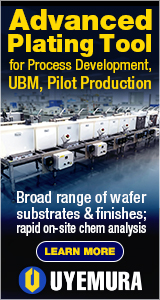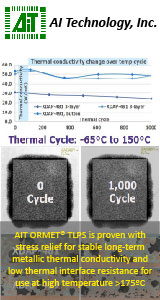|

|
|
| Ask the Experts | |||||||
|
|||||||
|
December 11, 2017 - Updated June 28, 2010 - Originally Posted Through Hole Component Phase OutHow long do you expect the industry will continue to use through-hole components? I can envision connectors being used for some time, but what about other component types? J. C. |
|||||||
| Expert Panel Responses | |||||||
|
Most electronic gadgets are designed to interface with humans in some fashion. We humans are very abusive to most electronic devices. We drop them, poke them, open and close them, and in general feed stuff into and out of them. It is well understood that a through-hole connection to the PCB is better mechanically than most SMT connections. The strength of the bond that holds a surface mount component to the PCB is limited to the strength of the glue that holds the copper pad to the surface of the laminate. As parts get smaller, so does the amount of glue under the ever decreasing copper pad size and thus the strength of the bond. As long as we humans have to touch it, switches, connectors and other mechanical devices are better attached to the circuit boards with through-hole connections. This is also true for devices which may encounter high forces, such as those used in rough service environments like military and aerospace, not to mention automotive. The parts are more likely to stay on the board if through-hole, and when stuff has to keep working under extreme accelerations, like lift-off, explosions or auto accidents, you don't want connectors falling of the boards. So until the electronics can interface with our brains without needing to be touched, poked, or just held, through-hole parts will still be with us. And for high reliability assemblies, a certain amount of parts will still need to be better secured to the board using the strength of the through-hole connection.
Senior Project Engineer Electronic Controls Design Inc Paul been with Electronic Controls Design Inc. (ECD) in Milwaukie, Oregon for over 39 years as a Senior Project Engineer. He has seen and worked with the electronic manufacturing industry from many points of view, including: technician, engineer, manufacture, and customer. His focus has been the design and application of measurement tools used to improve manufacturing thermal processes and well as moisture sensitive component storage solutions.
Back in 1980, the thought was surface mount technology was going to replace all through hole components and technology within a 5 to 10 year window. Here we are 30 years later and we are still building electronic products with through-hole technology. Unless there is a dramatic shift in the types of products we build, from such industries as the medical, military and commercial world and commodity products, I don't see an end to the use of through-hole type components, including connectors. My opinion is it will not happen until we get the acceptance to use commodity products and materials by the high reliability product community. A recent report in the June 22, 2010 Computerworld Newsletter, discussed the following Title: "More than a quarter of iPhones break within 2 years". This is an unacceptable performance level when considering the short lifetime of these products and I would think and suspect that this is not an acceptable reliability requirement for any other community other than the commodity products community. Just imagine if 25% of all your electronic products failed, could you ask yourself or admit to yourself that this is acceptable and reliable product? I would not think so! Just ask yourself how you would feel if your home electronic products starting failing at a rate of 25% every two years. The EU directive to change to lead-free product has also impacted the total conversion to surface mount, as it is still being debated in many forums as to the reliability of these lead-free materials and products and until all the reliability work and evaluations are concluded I don't see it happening. I look forward to hearing from the others as to their thoughts on this subject.
Vice President, Technical Director EPTAC Corporation At EPTAC Corporation, Mr. Lambert oversees content of course offerings, IPC Certification programs and provides customers with expert consultation in electronics manufacturing, including RoHS/WEEE and lead free issues. Leo is also the IPC General Chairman for the Assembly/Joining Process Committee.
The use of through-hole components depends on several factors:
Manager Advanced Development Assembleon Sjef van Gastel is manager of advanced development at Assembleon Netherlands B.V. He is responsible for technology roadmapping, technology investigations leading towards new machine concepts and for competitive dynamics. He is principal author of the book 'Fundamentals of SMD assembly.'
When we started developing SMT tools in the late 1980's the phase out of thru hole components was just around the corner. 20 plus years later we see less thru hole but still a large percentage of boards are still built with thru hole components. I still think we are a long way from that corner.
Regional Sales Manager OK International Inc. Ed Zamborsky is a Regional Sales & Technical Support Manager for Thermaltronics, located in New York. His position requires frequent customer visits throughout North America and the Caribbean and his position encompasses not only sales but the role of trainer and master applications engineer for all of Thermaltronics products. His expertise includes such specialties as hand soldering, convection and conduction reflow techniques, array rework, fluid dispensing equipment, and fume extraction. Ed has authored many articles and has presented many papers on topics such as; Low Volume SMT Assembly, Solder Fume Extraction, SMT Rework, BGA Rework, Lead-Free Hand Soldering, High Thermal Demand Hand Soldering, Lead Free Visual Inspection and Lead Free Array Rework.
Reader Comment
Excellent observations by the panel. Especially appreciate the comments on reliability (or lack there of) Legacy components will continue to be used as long as they are available. They remain well suited to many applications but they will be eventually be undercut by SMT devices which use less material and will thus be cheaper in the long run. To address the flagging reliability challenge, Verdant has been promoting the elimination of solder from the manufacturing process for the last 8 years.
Solder is known the be the primary source of both defects and failure. Solder elimination can be accomplished with the existing infrastructure making less expensive and more reliable products but the pain in the manufacturing body has yet to be sufficiently intense to cause the brain react.
Joseph Fjelstad, Verdant Electronics, USA
|
|||||||
| Submit A Comment | |||||||
|
Comments are reviewed prior to posting. You must include your full name to have your comments posted. We will not post your email address. |
|
Free Newsletter Subscription
Circuitnet is built for professionals who bear the responsibility of looking ahead, imagining the future, and preparing for it. Insert Your Email Address |
|

|






